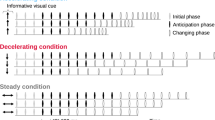Abstract
This study concentrated on three main questions: 1) can anticipatory late negative shift (expectancy wave, E-wave) be elicited in nonmotor S1-S2 paradigm, 2) is it sensitive to variation of emotional aspects of the task and 3) is there a connection between heart rate (HR) responses and E-wave. S1 was a letter row that was replaced tachistoscopically by another letter row (S2). The task of the subjects (n=12) was to detect if the critical aspects of S2 were similar to S1. After their delayed response they received feedback of their performance. The emotional aspects of the task were varied by presenting aversive noise bursts at the end of the feedback period either always, contingently to their performance or not at all. A negative shift was present both before S2 and aversive noise (when presented). Varying the emotional aspects of the task had an effect on the amplitude of the E-wave. There was also a connection between E-wave and heart rate responses: heart rate response seemed to be a precondition for E-wave elicitation. The results support Simons’s conclusion that nonmotor E-wave reflects specifically emotional anticipation.
Similar content being viewed by others
References
Bohlin, G. & Kjellberg, A. (1979). Orienting activity in two-stimulus paradigms as reflected in heart rate. In: Kimmel, H.D., van Olst, E.H. & Orlebeke, J.F. (eds.),The orienting reflex in humans. Hillsdale, NJ: Lawrence Erlbaum Associates, Publishers.
Brunia, C.H.M. (1988). Movement and stimulus preceding negativity.Biological Psychology, 26: 1–3, 165–178.
Brunia, C.H.M. & Damen, E.J.P. (1988). Distribution of slow brain potentials related to motor preparation and stimulus anticipation in a time estimation task.Electroencephalography and Clinical Neurophysiology, 69: 3, 234–243.
Damen, E.J.P. & Brunia, C.H.M. (1987). Changes in heart rate and slow brain potentials related to motor preparation and stimulus anticipation in a time estimation task.Psychophysiology, 24: 6, 700–713.
Gaillard, A.W.K. (1978). Slow brain potentials preceding task performance. Institute for Perception TNO Soesterberg, The Netherlands, Amsterdam: Academische Pres.
Gaillard, A.W.K. (1980). Cortical correlates of motor preparation. In: Nickerson, R.S. (ed.),Attention and performance VIII. Hillsdale, NJ: Lawrence Erlbaum Associates, Publishers.
Klorman, R. & Ryan, R.M. (1980). Heart rate, contingent negative variation, and evoked potentials during anticipation of affective stimulation.Psychophysiology, 17: 6, 513–524.
Loveless, N.E. (1979). Event-related slow potentials of the brain as expressions of orienting function. In: Kimmel, H.D., van Olst, E.H. & Orlebeke, J.F. (eds.).The orienting reflex in humans. Hillsdale, NJ: Lawrence Erlbaum Associates, Publishers.
McCallum, W.C. (1988). Potentials related to expectancy and motor activity. In Picton, T.W. (ed.).Human event-related potentials. Handbook of electroencephalography and clinical neurophysiology (revised series 3), 427–534. Amsterdam: Elsevier.
Rohrbaugh, J.W. & Gaillard, A.W.K. (1983). Sensory and motor aspects of the contingent negative variation. In: Gaillard, A.W.K. & Ritter, W. (eds.).Tutorials in event-related potential research: Endogenous components. Amsterdam: North-Holland.
Rohrbaugh, J.W., Syndulko, K. & Lindsley, D.B. (1976). Brain wave components of the contingent negative variation in humans.Science, 191: 4231, 1055–1057.
Ruchkin, D.S., Sutton, S., Mahaffrey, D. & Glaser, J. (1986). Terminal CNV in the absence of motor response.Electroencephalography and Clinical Neurophysiology, 63: 5, 445–463.
Simons, R.F. (1988). Event-related slow brain potentials: A perspective from ANS psychophysiology. In: Ackles, P.K., Jennings, J.R. & Coles, M.G.H. (eds.).Advances in Psychophysiology 3, Greenwich: JAI Press.
Simons, R.F., Öhman, A. & Lang, P.J. (1979). Anticipation and response set: Cortical, cardiac and electrodermal correlates.Psychophysiology, 16: 3, 222–233.
Author information
Authors and Affiliations
Additional information
Partial results of this study have been presented as an invited paper in the 5th International Congress of Psychophysiology, Budapest, Hungary, July 1990 (Heikki Lyytinen, Mikko Aro, & Miika Liimatainen: Autonomical and cortical responses during the anticipation of sensory task and feedback of results).
Rights and permissions
About this article
Cite this article
Aro, M., Liimatainen, M. & Lyytinen, H. E-wave and heart rate responses during anticipation of nonmotor events. Integrative Physiological and Behavioral Science 29, 431–446 (1994). https://doi.org/10.1007/BF02691363
Issue Date:
DOI: https://doi.org/10.1007/BF02691363




